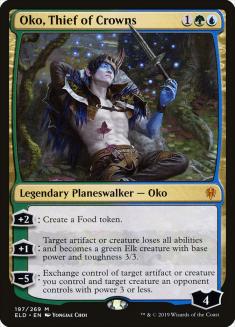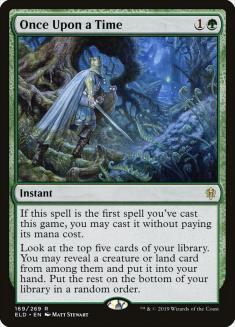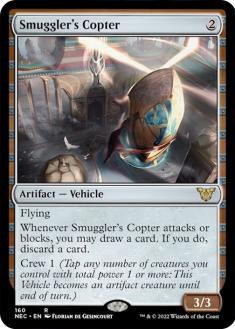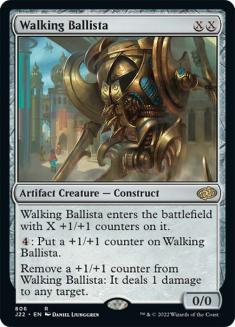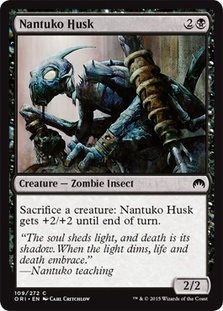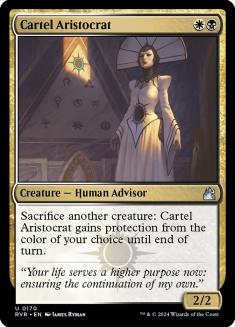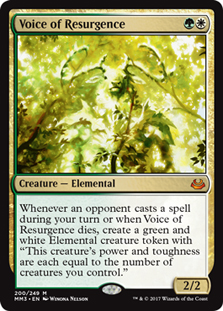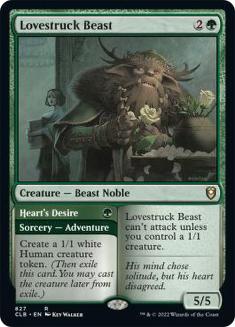When the Pioneer format was announced last month, one of the first cards that sprang to mind as a powerful build-around was Collected Company. The card was dominant during its run in Standard, and has seen significant play in Modern. That seemed like a clear sign that it would be a top contender in the intervening format, especially with several great mana creatures to help power it out ahead of schedule.
But we haven’t seen much of the powerful instant, and now that the format is developing a clear metagame, it’s getting less and less likely that its breakout is coming. But I’m not ready to give up just yet. So I’ve been thinking a lot about why the card has underperformed, the issues it’s facing, and how we may better utilize it in the Pioneer format.
The Problem With Bant Company
In its time in Standard, Collected Company was best paired with powerful, interactive three-drops like Reflector Mage and Spell Queller. This led fairly quickly to a Bant shell that remained the hallmark of the archetype for months. That idea carried over to Pioneer in the early weeks, as most players went about trying to update the old, successful shell for the new format. However, a lot has changed for Bant in the last couple of years, and changed for the better:
It’s hard to justify playing a disruptive, aggressively slanted Bant shell without these two powerful planeswalkers. Each has been a multi-format all-star since its printing, and in the case of Oko, it’s been removed from Standard faster than any card since Felidar Guardian. There’s no denying the power of these cards, and unfortunately, they do not play well with Collected Company.
There’s the obvious strike against that neither is a creature, but you can massage the numbers to fit them alongside Collected Company and 27+ creatures, and because both planeswalkers help control the battlefield, which is what Collected Company decks want out of their other spell slots, it’s not a bad fit. The bigger issue for me is curve.
Collected Company decks not only want to hit two creatures consistently from their namesake spell, they want to maximize the power of those creatures, which typically means maximizing their combined mana cost. The best Collected Companies hit two three-drops, thus generating both card advantage and tempo at the same time – the hallmark of winning Magic over the last five years.
Of course you can’t fill your deck with three-mana creatures, because then you fall behind on the first two turns of the game too often. This is why Collected Company has historically played well with mana creatures – you can inflate the number of three-mana creatures in your deck without sacrificing consistent curves. However, you can’t include Oko, Thief of Crowns and Teferi, Time Raveler, and then fill out your deck with the requisite number of thee-mana creatures to maximize the effectiveness of Collected Company. Your curve becomes glutted at three, without the ability for Collected Company to consistently make up for the inconsistency such a curve generates.
Collected Company is a powerful card, but it’s not on the level of Oko, Thief of Crowns. So step one for rethinking Collected Company in Pioneer is to get out of the Bant trap.
The Other Competition
Unfortunately for Collected Company, the competition doesn’t stop with planeswalkers. One of the other major strengths of the card was the velocity it provided, offering creature decks a level of consistency they wouldn’t have otherwise. Right now, there are two other cards in Pioneer doing similar things and enjoying much more success: Once Upon a Time and Smuggler’s Copter.
The biggest benefit of these cards is how little they require from deckbuilding. Once Upon a Time is a fine card so long as your deck has some creatures and green mana, and Smuggler’s Copter doesn’t even require the green mana. They are easy to pair with whatever creatures you want, and can pay you off handsomely with the right pairings. Once Upon a Time ensures the green aggro decks can start on a mana creature a huge portion of the time, while Smuggler’s Copter smooths out your draws turn after turn, forming the backbone of the Mono-Black Aggro deck while appearing in Izzet Ensoul and Azorius Flash among others.
We could try to play Collected Company beside these cards, but as I mentioned earlier, Company decks desperately need interaction from their non-Company spells, and neither fills that hole. And when choosing between them, these cards are on a similar power level to Collected Company when compared to their cost, so asking essentially nothing from your deckbuilding puts them significantly ahead. If we’re going to use Collected Company, we need to be doing something that it does better than Once Upon a Time and Smuggler’s Copter.
Thinking along those lines, it’s clear to me that we need Collected Company to be developing powerful, creature-based synergies. Finding two pieces to a combo or an engine from one card can turn around games instantly, and in those decks, the high immediate impact of Collected Company is quite valuable.
We don’t have Devoted Druid or Kitchen Finks like we do in Modern, but Pioneer is a large format, and there should be something powerful to build around. There’s the obvious route of developing tribal synergies, but I haven’t been impressed by Spirits or Elves, so I think we can do better.
The Walking Ballista Problem
This one is more metagame-based. When Pioneer was announced, it wasn’t exactly clear what decks would rise to the top, but over the last month it’s clear that Walking Ballista is a staple of the format. It’s a great payoff for Mono-Green Devotion and Hardened Scales decks since it plays at every stage of the game while still being overwhelmingly powerful in your best draws.
And that’s a problem for Collected Company, since decks built around the card are full of cheap creatures, and usually don’t have a lot of ways to take it off the battlefield. Reflector Mage would only stop it for a time, Deputy of Detention doesn’t help if it has more than three counters, and Spell Queller only works if it’s cast for two or less. This is yet another reason to move away from Bant and towards a color combination that offers some effective removal options to round out the deck.
Removal in Pioneer has centered around the Golgari colors, and that works well for these decks, since Fatal Push, Abrupt Decay, and Assassin’s Trophy are quite flexible. When you don’t have much space for removal spells, it’s important that the ones you do play are versatile, so you aren’t finding yourself with dead cards too often.
Playing black also gives us access to Blightbeetle, a haymaker against Walking Ballista if it enters the battlefield first. That said, Walking Ballista decks have declined somewhat from their peak a week or two ago, which means we may not even need the most extreme measures. But it’s a good option to have.
Putting this all together, I was driven to Aristocrats-style shells. Black is great for added removal and developing sacrifice synergies, and these decks both appreciate the immediate impact of Collected Company, and the card advantage it provides, helping you find your different enablers consistently as well as finding a critical mass of bodies to sacrifice.
The first list borrows the Cauldron Familiar / Witch’s Oven package from Throne of Eldraine, while also adding red to the Golgari base for Mayhem Devil:
Creatures (28)
- 4 Nantuko Husk
- 1 Liliana, Heretical Healer
- 3 Catacomb Sifter
- 4 Blisterpod
- 4 Zulaport Cutthroat
- 4 Mayhem Devil
- 4 Gilded Goose
- 4 Cauldron Familiar
Lands (21)
Spells (11)
Sideboard

Witch’s Oven offers a critical second sacrifice outlet, though sadly not one findable with Collected Company, and Mayhem Devil offers some additional interaction, so you don’t need as many slots for straight removal spells. The sideboard is filled with additional disruption, depending on the matchup, since Jund is certainly not short on removal options.
Playing Witch’s Oven also allows for Gilded Goose as an excellent mana creature and some much-appreciated mana fixing in a deck that as it stands is a little shy on red mana for Mayhem Devil. Collected Company does some lifting there but Goose is also valuable. These decks want to double-spell early and often to develop a wide battlefield, so any extra mana early will help, and then once it’s done its job it can serve as fodder for your sacrifice synergies.
The real all-star here is Nantuko Husk, a perennially underrated creature that quickly becomes a functional The Abyss in creature matchups while also enabling combo-esque kills should you find enough copies of Mayhem Devil and Zulaport Cutthroat. The fact that Devil can clear out blockers instead of going upstairs makes Husk all the more dangerous, and you should frequently be doing the math to figure out if your opponent is dead or not, since you’ll be surprised how often Nantuko Husk is a lethal attacker.
Catacomb Sifter is another card I think is being overlooked right now. It saw significant play in its Standard environment because its stats stand by themselves, even before considering how effective it is with all the sacrifice synergies here. The extra scry triggers let you get even more aggressive, often starting on your upkeep to dig for a key removal spell or Collected Company to put the game away with Nantuko Husk.
I like that this deck gets to play a ton of reach at a low cost with Mayhem Devil, Zulaport Cutthroat, and Cauldron Familiar so it’s not reliant on attacking through a horde of Zombie tokens generated by Field of the Dead, and note that you do have Gilded Goose which can block Ormendahl, Profane Prince, sacrificing it before damage to prevent your opponent from gaining life.
You can also opt for white over red, which offers a ton of additional cards:
Creatures (31)
- 4 Nantuko Husk
- 4 Cartel Aristocrat
- 4 Voice of Resurgence
- 4 Blisterpod
- 4 Zulaport Cutthroat
- 3 Hunted Witness
- 4 Cruel Celebrant
- 4 Lovestruck Beast
Lands (22)
Spells (7)

The big additions here are Cartel Aristocrat and Voice of Resurgence. Both are very powerful cards, and push us in a more aggro, less combo direction. The Elemental token from Voice of Resurgence is a great attacker in this deck, and Cartel Aristocrat typically functions as a 2/2 unblockable creature, offering some measure of inevitability.
To supplement this aggro plan, I replaced Catacomb Sifter with Lovestruck Beast, giving the deck another above-rate creature, while also getting another one-drop for little cost. I’m not maindecking any removal, instead relying on the bigger creatures to dominate the battlefield, and Abzan Ascendancy to both protect from removal and go to the air should combat on the ground stall. That said, if some creatures underperform or I find the deck needs some removal in the maindeck, there’s room to add some with a relatively high 31 hits for Collected Company in the maindeck.
White also provides some excellent Collected Company hits out
of the sideboard in Sin Collector and Knight of Autumn, making the process of
sideboarding while maintaining a high number of hits for the card much easier.
My worry with this list is speed. You may need to play a mana creature to help
the deck churn out its creatures quickly enough, and playing enough early green
sources to enable Llanowar Elves could make casting the various Orzhov cards
too difficult. It’s possible this deck then wants some number of Once Upon a
Time to help find those mana creatures as well as smooth out the mana, but this
is where I’d start.
The best Collected Companies hit two three-drops, thus generating both card advantage and tempo at the same time – the hallmark of winning Magic over the last five years.
Pioneer is starting to slow down, with a clear set of established decks at the top and a host of other archetypes floating around the fringe. But that doesn’t mean it’s entirely stagnant. It took years to discover some of the most famous decks in Modern, from Mono-Green Tron to Lantern Control to Amulet Titan. Collected Company isn’t as obscure as those decks, but it’s clear that our existing template for Company decks isn’t working. It’s time to go back to square one and figure out how this card fits into the new world of Pioneer, and these decks are a great start to that endeavor.

